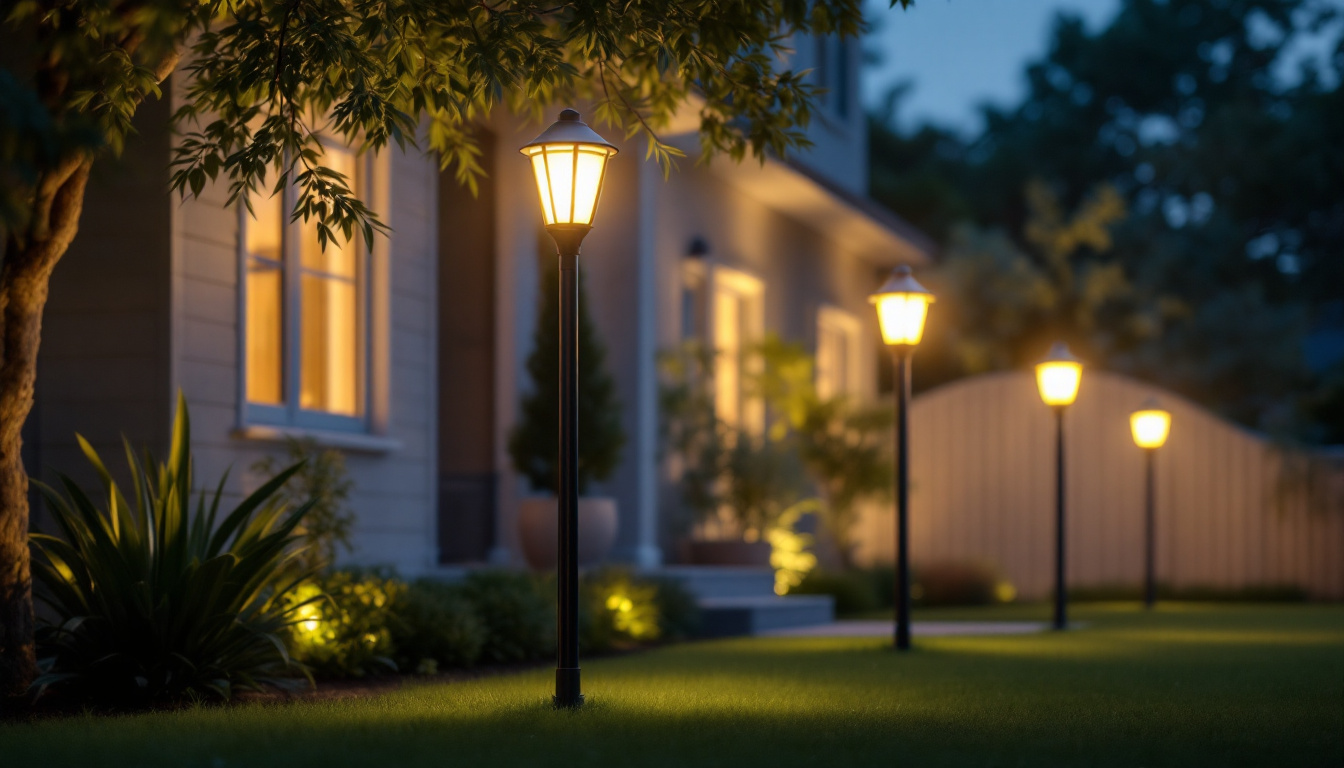
In the ever-evolving world of lighting solutions, exterior motion sensor lights have emerged as a transformative technology. These innovative fixtures not only enhance security but also contribute to energy efficiency and convenience. For lighting contractors, understanding the benefits and applications of these lights is crucial in meeting the demands of modern clients.
As homeowners increasingly seek smart and sustainable solutions, the adoption of exterior motion sensor lights is rapidly gaining momentum. This article delves into the reasons why these lights are considered a game-changer in the lighting industry, exploring their functionality, benefits, and the impact they have on both residential and commercial applications.
One of the standout features of exterior motion sensor lights is their ability to detect movement and respond accordingly. Utilizing advanced infrared technology, these lights can sense the heat emitted by moving objects, activating the light only when necessary. This not only provides illumination when it is most needed—such as when someone approaches the front door—but also significantly reduces energy consumption by ensuring that lights are not left on unnecessarily. Many models also offer adjustable sensitivity settings, allowing homeowners to customize the range and responsiveness of their lights based on their specific needs and the layout of their property.
In addition to their practical benefits, exterior motion sensor lights can also enhance the aesthetic appeal of a property. Available in a variety of styles and finishes, these lights can complement the architectural features of a home or business, adding a touch of elegance while providing essential safety. Moreover, with the integration of smart technology, many motion sensor lights can now be controlled remotely via smartphone apps, enabling users to monitor and manage their outdoor lighting from anywhere. This level of control not only adds convenience but also allows for the creation of dynamic lighting schemes that can adapt to different occasions, from welcoming guests to securing the premises during the night.
At the heart of exterior motion sensor lights lies advanced technology that detects movement and activates lighting accordingly. This section will explore the various types of motion sensors commonly used in exterior lighting, shedding light on how they work and their unique features.
There are primarily three types of motion sensors utilized in exterior lighting: passive infrared (PIR), microwave, and dual-tech sensors. Each type has its own operational principles and applications.
Passive infrared sensors detect body heat emitted by humans and animals. They are ideal for outdoor settings, as they can cover a wide area and are energy-efficient. Microwave sensors, on the other hand, emit microwave signals and detect movement based on the reflection of these signals. They are more sensitive and can detect motion through obstacles, making them suitable for various environments.
Dual-tech sensors combine both PIR and microwave technologies, offering the best of both worlds. This hybrid approach minimizes false alarms while ensuring reliable detection, making them a popular choice for many contractors.
Motion sensors operate by monitoring a designated area for any changes in infrared radiation or microwave signals. When movement is detected, the sensor triggers the lighting system, illuminating the space for a predetermined duration. This functionality not only enhances safety but also conserves energy by ensuring lights are only on when needed.
Additionally, many modern motion sensors come equipped with adjustable settings, allowing contractors to customize the sensitivity, duration, and range of detection. This flexibility is essential in catering to the diverse needs of clients.
The advantages of incorporating exterior motion sensor lights into lighting designs are manifold. From energy savings to increased security, these lights offer numerous benefits that appeal to both contractors and homeowners alike.
One of the most significant benefits of exterior motion sensor lights is their ability to enhance security. By illuminating areas when movement is detected, they deter potential intruders and provide peace of mind for homeowners. Well-lit exteriors can significantly reduce the risk of break-ins and vandalism.
Moreover, these lights can be strategically placed around properties to cover vulnerable entry points, such as driveways, patios, and garages. This targeted illumination not only protects the property but also creates a safer environment for residents and visitors.
Energy efficiency is a key consideration in today’s lighting designs. Exterior motion sensor lights contribute to reducing energy consumption by ensuring that lights are only activated when necessary. This feature is particularly beneficial in areas where lights may otherwise remain on for extended periods.
By utilizing LED technology in conjunction with motion sensors, contractors can offer clients a sustainable lighting solution that not only saves energy but also lowers electricity bills. The combination of motion sensors and energy-efficient bulbs is a win-win for both the environment and homeowners’ wallets.
Incorporating exterior motion sensor lights into a property’s lighting design adds a layer of convenience that many homeowners appreciate. These lights can automatically illuminate pathways and entryways, providing safe navigation during the night without the need for manual switches.
Furthermore, with the rise of smart home technology, many motion sensor lights can now be integrated with home automation systems. This allows homeowners to control their lighting remotely, set schedules, and receive alerts when motion is detected, enhancing both convenience and security.
Exterior motion sensor lights are versatile and can be employed in various settings, from residential homes to commercial properties. Understanding their applications helps contractors recommend the best solutions for their clients.
In residential settings, exterior motion sensor lights are commonly used for security and safety purposes. Homeowners often install them around entry points, such as front doors and garages, to deter intruders and provide illumination for late-night arrivals.
Additionally, these lights can enhance outdoor living spaces, such as patios and decks, allowing homeowners to enjoy their outdoor areas even after sunset. By providing targeted lighting, motion sensors create a welcoming atmosphere while ensuring safety.
For commercial properties, exterior motion sensor lights serve both security and operational functions. Retail establishments, parking lots, and office buildings benefit from enhanced visibility, reducing the risk of accidents and crime.
Moreover, businesses can save on energy costs by utilizing motion sensors in less frequented areas, such as storage rooms and loading docks. This efficient use of lighting not only lowers expenses but also aligns with corporate sustainability goals.
When installing exterior motion sensor lights, contractors must consider several factors to ensure optimal performance and client satisfaction. This section outlines key considerations that can impact the effectiveness of these lighting solutions.
Proper placement of motion sensor lights is crucial for maximizing their effectiveness. Contractors should assess the property layout and identify key areas that require illumination. Factors such as the height of installation, sensor range, and potential obstructions should be taken into account to ensure comprehensive coverage.
Additionally, it is essential to consider the angle of detection. Motion sensors typically have a specific field of view, and positioning them correctly can significantly enhance their ability to detect movement.
Given that exterior motion sensor lights are exposed to the elements, selecting weather-resistant and durable fixtures is paramount. Contractors should choose products that are rated for outdoor use and can withstand varying weather conditions, including rain, snow, and extreme temperatures.
Investing in high-quality materials not only ensures longevity but also reduces the need for frequent replacements, ultimately benefiting both contractors and clients.
The lighting industry is continuously evolving, and motion sensor technology is no exception. As advancements in technology continue to emerge, several trends are shaping the future of exterior motion sensor lights.
As smart home technology becomes increasingly prevalent, the integration of motion sensor lights with home automation systems is expected to grow. This trend allows homeowners to control their lighting remotely, set schedules, and receive notifications, enhancing both convenience and security.
Contractors who stay abreast of these advancements can provide clients with cutting-edge solutions that align with their lifestyle and preferences.
Energy management systems are gaining traction in the lighting industry, and motion sensor lights play a significant role in these solutions. By integrating motion sensors with energy management systems, contractors can offer clients comprehensive solutions that optimize energy usage and reduce costs.
This trend not only appeals to environmentally conscious consumers but also aligns with the growing demand for sustainable practices in the lighting industry.
Exterior motion sensor lights represent a significant advancement in the lighting industry, offering enhanced security, energy efficiency, and convenience. For lighting contractors, understanding the technology, benefits, and applications of these lights is essential in meeting the evolving needs of clients.
As the demand for smart and sustainable lighting solutions continues to rise, embracing the potential of exterior motion sensor lights will position contractors at the forefront of the industry. By staying informed about installation considerations and future trends, contractors can provide exceptional service and innovative solutions that enhance the safety and functionality of outdoor spaces.
In summary, the integration of exterior motion sensor lights into lighting designs is not merely a trend but a transformative shift that promises to redefine how we illuminate our surroundings. Embracing this technology will undoubtedly lead to a brighter and more secure future for both contractors and their clients.
Ready to elevate your lighting projects with the game-changing benefits of exterior motion sensor lights? At LumenWholesale, we provide lighting contractors with an exceptional range of spec-grade lighting products, including the latest in motion sensor technology. Our commitment to quality and affordability ensures you have access to the best lighting solutions at wholesale prices that simply can’t be beaten. Say goodbye to middleman markups and hello to free shipping on bulk orders, making your purchases even more cost-effective. Don’t compromise on quality or value; choose LumenWholesale for your lighting needs and experience the ultimate in convenience and reliability. Wholesale Lighting at the Best Value is just a click away.

Discover why surface mount flat panel LED lights are revolutionizing the lighting industry.

Discover how outdoor path lights powered by solar energy can enhance safety and aesthetics in your outdoor spaces.

Discover the common oversights lighting contractors make when installing yard light poles.

Discover essential strategies and tips for lighting contractors to effectively utilize wall pack lights.